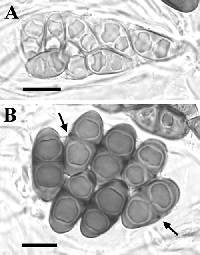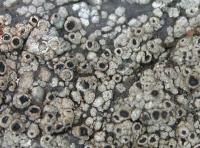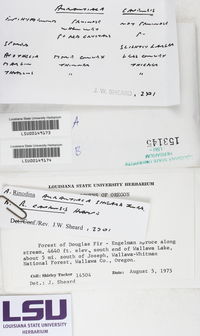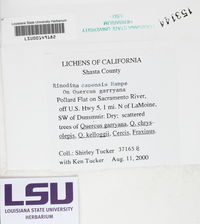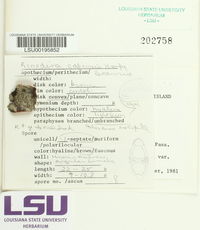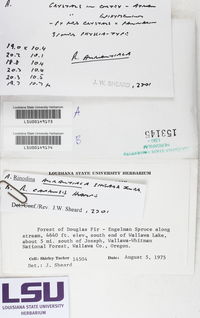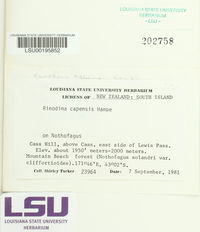
- Home
- Search
- Images
- Species Checklists
- US States: O-Z >
- US National Parks
- Central America
- South America
- US National Parks
- Southern Subpolar Region
|
|
|
|
Family: Physciaceae
[Rinodina aurantiaca Sheard, moreRinodina corticola (Arnold) Arnold] |
MB#404251 Type. AFRICA MERIDIONALIS, corticola (VER - holotype, Giralt & Mayrhofer, 1994). Rinodina corticola (Arnold) Arnold, Verh. K.K. Zool.‑Bot. Ges. Wien 29: 370 (1879). Exsiccatae. Arnold Lich. Exs. [Jurae] 1762a, 1787a (K in BM, BM); Krypt. Exs. Vind. 2079 (K in BM), 2079 (NY pro parte); Vězda Lich. Sel. Exs. 624 (BM) all as R. corticola. Description. Thallus thin, light grey, areolate; areoles discrete at first, becoming contiguous, to 0.20-0.65(-0.80) mm wide; surface plane or slightly convex, matt; margin determinate or not; prothallus lacking; vegetative propagules absent. Apothecia narrowly attached, frequent, rarely contiguous, to 0.50-0.70(-1.00) mm in diam.; disc black, not pruinose, plane to slightly convex; thalline margin concolourous with thallus, 0.05-0.10 mm wide, entire, persistent or becoming thinner by exclusion; excipular ring sometimes present, raised. Apothecial Anatomy. Thalline exciple 50-90(-110) µm wide laterally; cortex 5-15 µm wide; epinecral layer absent; crystals present in cortex, absent in medulla; cortical cells to 4.0-7.0 µm wide, rarely pigmented; algal cells to 11.5-17.5 µm long; thalline exciple 70-110(-140) µm below; cortex expanded 35-70 µm deep, columnar, I+ blue; proper exciple hyaline or lightly pigmented, 5-15 µm wide laterally, widening 15-30(-40) µm at periphery; hypothecium hyaline, (50-)70-120 µm deep; hymenium 80-120 µm high, not inspersed; paraphyses 2.0-2.5 µm wide, often conglutinate, with apices to 3.5-5.0 µm wide, lightly or heavily pigmented and immersed in dispersed pigment forming a red‑brown epihymenium; asci 60-80 x 14-23 µm. Ascospores 8/ascus, developmental type A, Physcia‑type, (16.0-)18.5-19.5(-22.0) x (7.0-)9.0-10.0(-12.0) µm, average l/b ratio 1.9-2.1, bluntly ellipsoid, apical walls remaining thick until very late; torus narrow; walls lightly ornamented. Pycnidia infrequent, immersed in thallus with only darkly pigmented ostiole exposed; conidiophores type I, conglutinate; conidia bacilliform, 4.0-5.0 x ca. 1.0 µm; Chemistry. Spot tests, K+ yellow, C-, KC-, P- or P+ faint yellow; secondary substances, atranorin in cortex, zeorin (trace) in medulla. Substrate and Ecology. Recorded from both coniferous and deciduous trees, including Abies bracteata, A. concolor, A. magnifica, Acer glabrum, Alnus incana, Ceanothus, Cupressus abramsiana, Fraxinus latifolia, Juglans, Juniperus, Picea glauca, Pinus ponderosa, Populus tremuloides, Pseudotsuga menziesii, Quercus dumosa, Q. durata, Q. garryana, Q. kellogii, Q. pacifica and Salix, frequent on twigs and small branches, rarely on wood, at elevations of 550-2 655 m. Frequently accompanied by other Rinodina species including R. aurantiaca, R. badiexcipula, R. boulderensis, R. californiensis, R. dilatata, R. disjuncta, R. endospora, R. herrei, R. laevigata, R. marysvillensis, R. metaboliza, R. oregana and R. santae-monicae. Distribution. Rinodina capensis is distributed in the Coastal Ranges, Sierra Nevada and Rocky Mountains. It is widespread in southern and central Europe, Macaronesia and also is found in southern Africa (Giralt 2001). Notes. Rinodina capensis was first reported from North America by Magnusson (1953, as R. corticola) but this material has a P+ epihymenium (red crystals of pannarin) and belongs to R. aurantiaca. The two species are otherwise very similar possessing atranorin in the cortex, an expanded, columnar, lower cortex and Physcia‑type spores. The two species are compared in more detail under R. aurantiaca. A number of other species containing cortical atranorin might be mistaken for R. capensis. Rinodina exigua may have a similar habit although the thallus is typically better developed and its areoles larger. It is best distinguished by the lack of a wide, columnar cortex in the base of the apothecium. Although the lower cortex of R. exigua may be slightly expanded it always poorly organized. The spore walls of R. exigua are more consistently and strongly ornamented. Rinodina californiensis is distinguished by its Dirinaria-type, slightly shorter spores and lack of a columnar lower cortex. On the Pacific coast R. capensis might also be confused with immature R. bolanderi which also may have an expanded lower cortex but is distinguished by the larger, Teichophila-type spores that become inflated around the septum on application of KOH. In the Rocky Mountains R. boulderensis also has atranorin in the cortex but its Physcia-type spores are significantly smaller and are characterized by a prominent, dark torus. In addition, the thalline margin of the apothecium is often incompletely formed, a characteristic never observed in R. capensis and it always lacks a thick lower cortex. The above description of R. capensis agrees with accounts of the species from Europe, except that spores on that continent are longer (averaging 20-23 µm long) according to Giralt and Mayrhofer (1994a). Specimens examined. CANADA. ALBERTA. 2.2mi W Bryant Creek, R.M., Kalgutkar 1650; 5 mi SW Bragg Creek, R.M., Kalgutkar 1714, 1757, 1841, 1917; Jumping Pound, R.M., Kalgutkar 1124, 1532 (all PMAE); Red Deer River, J. Marsh 4438 (ASU, PMAE). BRITISH COLUMBIA. 10 km NNW Pemberton, T. Tønsberg 12761 (BG); 1 km S Mt. Robson, E. Lay 1597 (personal herb); 5.4 mi E Creston, C.M. Wetmore 18763 (ASU, MIN); Fernie, C.M. Wetmore 18718B (MIN); I.M. Brodo 15085B (CANL); Wells Gray Prov. Park, 1994, T. Goward (GZU); C. Bjorke 10765 (Goward personal herb). U.S.A. ARIZONA. Cochise Co., Chiricahua Mountains, W.A. Weber 36935 (COLO); Coconino Co., Grand Canyon Forest, 1994, S.C. Tucker (ASU). CALIFORNIA. Lake Co., 8 mi NE Potter Valley, S.C. Tucker 35461; near Pillsbury Reserve, S.C. Tucker 35375A (both SBBG); Soda Springs Ranger Station, S.C. Tucker 35460; Los Angeles Co., Mt. Mooney Road, B.D. Ryan 26207c, 27207 (all ASU); Santa Monica, 1894, H.E. Hasse (NY); Sepulveda Canyon, 1900 (NY); Madera Co., 19 mi NW Coarsegold, B.D. Ryan 24741b; Brown's Creek, B.D. Ryan 32102; North Fork, B.D. Ryan 32072; Rock Creek, B.D. Ryan 32168b; Sierra Nat. Forest, B.D. Ryan 32170 (all ASU); Marin Co., Mount Tamalpais, S.C. Tucker 37564 (SBBG); Mariposa Co., Yosemite Nat. Park, 1992, T. Tønsberg (BG); Mendocino Co., Hopland, 1969, R. Handley (UC); Monterey Co., Lucia, 1961, C.E. Wolf (COLO); Plumas Co., Lost Claim Camp, 1968, V. Duran (UC); Riverside Co., Mount San Jacinto, T.H. Nash 7075 (ASU); San Benito Co., Clear Creek, A. Carter 4423A (UC); San Mateo Co., Cahill Ridge, W. Jordan 635 (WIS); Santa Barbara Co., Santa Rosa Island, C.M. Wetmore 73537 (MIN); Santa Cruz Co., Bonny Doon, S.C. Tucker 6396b (SBBG); I. Tavares 2049 (UC); Santa Clara Co., Loma Prieta, A.C. Herre 2415 (UPS); Shasta Co., Cloverdale, 1888, Bolander (PH); 1 km W Lassen Volcano, B.D. Ryan 11307; Siskiyou Co., 2.5 mi SE Etna, B.D. Ryan 24868, 24874; 3 mi NE Seiad Valley, B.D. Ryan 25690a, 25692; 5 mi SW Scotts Bar, B.D. Ryan 25076a; 6 mi W Scotts Bar, B.D. Ryan 24995 (all ASU); McCloud, W.B. Cooke 37232b (MU); Tehama Co., Lassen Nat. Forest, 1975, L. Segal (ASU); Tulare Co., Kings Canyon Nat. Park, J.L. Blakeman 216 (MIN); Yolo Co., Winters, 1975, W.A. Weber (COLO). IDAHO. Benewah Co., Coeur d'alene, H. Goree 1342 (COLO); MrKrosey State Park, S.C. Tucker 36093 (SBBG). MONTANA. Lincoln Co., SE Eureka, T. Tønsberg 26468 (BG). NEW MEXICO. Catron Co., Mogollon, W.A. Weber 41273 (COLO); Santa Fe Co., Santa Fe, 1848, Fendler (FH). OREGON. Curry Co., Rogue River, S.C. Tucker 34987 (SBBG); Douglas Co., 3 km S Tenmile, B. McCune 27239; 3 km SSE Tenmile, B. McCune 28095 (both personal herb.); Jackson Co., 7 ml N Grants Pass, L.H. Pike 1150 (SASK); Josephine Co., Selma, 1969, L.H. Pike (CANL); Linn Co., Tombstone Pass, I. Tavares 127a (UC); Ravalli Co., Bear Creek Canyon, B. McCune 10876 (personal herb.); Wallowa Co., 5 mi S Joseph, S.C. Tucker 14504 (LSU). Selected References. Magnusson (1947a as R. corticola), Sheard (1967 p. 335 as R. corticola), Ropin & Mayrhofer (1993 Abb. 4, 8, 20), Giralt & Mayrhofer (1994a Fig. 2a), Giralt (2001 Plate XVI:D), Sheard (2004). DESCRIPTION of Rinodina aurantiaca Sheard, in Sheard & Mayrhofer, Bryologist 105(4): 652 (2002) Type. U.S.A. CALIFORNIA. Siskiyou Co., road to Etna Summit, 2.5 mi (4.8 km) SW of Etna city limits, 1 100 m, 19 August, 1989, B. Ryan 24832a, with R. exigua (ASU - holotype!). Taxonomic Note: according to Sheard, J.W. (2018) R. aurantiaca was recently synonymyzed with R. capensis. Description. Thallus thin, light grey, areolate; areoles discrete or contiguous, to 0.25-0.80 mm wide, rarely rimose; surface plane, matt; margin determinate or not; prothallus lacking; vegetative propagules absent. Apothecia narrowly attached, frequent, mostly not contiguous, to 0.35-0.60(-0.70) mm in diam.; disc black, often lightly pruinose (most visible when moist), plane to convex, rarely semi-globose; thalline margin concolourous with the thallus, ca. 0.05(-0.10) mm wide, entire, rarely excluded; excipular ring absent. Apothecial anatomy. Thalline exciple 45-70 µm wide laterally; cortex 5-20 µm wide; crystals present in cortex, absent in medulla; cortical cells to 4.5-5.5 µm wide, not pigmented; algal cells to 10.5-16.0 µm long; thalline exciple 60-90 µm wide below; cortex 25-55 µm deep, columnar; proper exciple hyaline, 5-10(-15) µm wide laterally, expanding to 10-20 µm wide at periphery; hypothecium hyaline, (30-)50-90 µm deep; hymenium not inspersed, 70-100 µm high; paraphyses ca. 2.0 µm wide, not conglutinate, with apices to 3.0-4.0 µm, lightly pigmented and immersed in a dispersed pigment, forming an orange- to light red-brown epihymenium, typically with included crystals; asci 50-75 x 16-25 µm. Ascospores 8/ascus, Type A development, Physcia-type, (16.5-)19.0-20.0(-23.0) x (8.0-)9.5-10.0(-11.5) µm, average l/b ratio 1.9-2.1, tending to become more bluntly ellipsoid at maturity, lumina becoming somewhat inflated but apices mostly remaining thick walled; torus mostly absent or narrow; walls lightly pigmented, ornamentation light or absent. Pycnicia not seen. Chemistry. Spot tests, K+ yellow, C-, KC-, P- or P+ faint yellow; epihymenium typically P+, forming red needles (with alcoholic P); secondary metabolites, atranorin, zeorin in thallus, pannarin in epihymenium. Substrate and Ecology. This species grows on the bark of conifers and deciduous trees, frequent on dead conifer twigs, in partially shaded, montane habitats. Recorded on Abies concolor, Acer glabrum, Alnus incana, A. oblongifolia, A. rubra, A. sinuata, Cornus, Picea engelmannii, P. glauca, Pinus monticola, P. strobiformis, Pseudotsuga menziesii, Quercus gambelii, Rhamnus purshiana and Salix scouleriana. Rinodina aurantiaca has been collected with R. badiexcipula, R. boulderensis, R. coloradiana, R. disjuncta, R. exigua, R. laevigata, R. oleae, R. orculata, and R. oregana. Recorded elevations range from 215 m in the northern part of its range to 2 745 m at its southern limit. Distribution. A western North American endemic species with a Cascades-southern Rocky Mountain distribution which ranges from southern British Columbia to northern California and from southern Alberta to Colorado, with southwestern outliers in Arizona. Brodo 15085b (CANL) reported as R. aurantiaca by Sheard & Mayrhofer (2002) is R. capensis. Collections of R. aurantiaca by Darrow from southern Arizona were the basis of the first records of R. capensis (as R. corticola) for North America (Magnusson 1953). Notes. This species is very similar in habit to R. capensis but its apothecia tend to have less prominent margins and the discs become more convex. Most importantly, R. aurantiaca and R. capensis, differ chemically. The former has pruinose discs, best seen when moist, caused by the presence of pannarin crystals within the epihymenium. Rinodina capensis lacks pannarin. Both species contain cortical atranorin, have an expanded lower apothecial cortex and Physcia-type spores of similar size. The relationship between R. aurantiaca and R. capensis appears to parallel that of the saxicolous R. brandii Giralt & Boom and R. confragosa in Europe (Giralt and Boom 1996). Rinodina aurantiaca has occasionally been collected with R. exigua (not R. capensis as reported by Sheard & Mayrhofer 2002) and the two species have a similar habit only distinguishable by the more narrowly attached apothecia of R. aurantiaca and their narrower margins. These two species also have very similar spore sizes. Rinodina exigua lacks the greatly expanded, columnar apothecial cortex and also has a more darkly pigmented epihymenium and spores. Rinodina marysvillensis is a more oceanic species possessing the same cortical and epihymenium reactions. However, its apothecia are typically larger and have more prominent margins, the pannarin crystals occur on the surface of the epihymenium rather than within it, and its spores are significantly smaller and belong to the Dirinaria-type. Collections of R. aurantiaca lacking pruinose discs may have a similar habit to R. boulderensis but the latter species may be distinguished by its smaller apothecia and typically incomplete, or otherwise poorly developed, thalline margins. Rinodina boulderensis lacks pannarin in the epihymenium and its Physcia-type spores are significantly smaller and possess a prominent torus. Specimens examined [and not recorded by Mayrhofer & Sheard (2002)]. CANADA. ALBERTA. Bryant Creek, R.M. Kalgutkar 1631; Jumping Pound, R.M. Kalgutkar 1603 (both PMAE). BRITISH COLUMBIA. Blaeberry River road, J.W. Sheard 5284 (SASK); Bralorne, Lillooet Valley, T. Tønsberg 12821 (BG); near Brandywine Falls, S Whistler, T. Tønsberg 12750 (BG); Kokanee Creek Prov. Park, J.W. Sheard 5276 (SASK); E Pemberton, I.M. Brodo 8312 (CANL, COLO, PMAE); 14 mi S Squamish, I.M. Brodo 8159 (CANL, PMAE); E Upper Arrow Lake, T. Tønsberg 26408, 26409 (BG); Wells Gray Prov. Park, Dawson Falls, Helmken Falls, 2 Sept., 1991, J.W. Sheard, 25 Aug., 1994, Goward & Poelt (SASK). U.S.A. ARIZONA. Graham Co., Moonshine Canyon, R.A. Darrow 1844 (COLO, WIS); 1845 (ASU); T.H. Nash, 16624 (ASU); Shannon Camp, R.A. Darrow 1770, 1850 (UPS); 1778 (WIS, UPS); Pima Co., Mica Mountain, C.M. Wetmore 54028, 55029 (MIN). CALIFORNIA. Eldorado Co., 2 mi E Kyburz, S.C. Tucker 34017; 3 mi E Kyburz, S.C. Tucker 34110B (both SBBG); San Mateo Co., Skyline Drive, S.C. Tucker 13423 (LSU); Sierra Co., 11 mi W Donnieville, 992, S.C. Tucker 31863 (SBBG); Tulare Co., Kings Canyon Nat. Park, J.L. Blakeman 242, 252 (MIN). IDAHO. Bonner Co., Priest Lake, B. McCune 22561; Idaho Co., 7 km W Lowell, B. McCune 10173B (both personal herb.); Lochsa River Valley, T. Tønsberg 26587, 26593d, 26610 (BG). MONTANA. Flathead Co., Bowman Lake, McCune 19186 (SASK); Sanders Co., Cabinets Mountains, M. Hauk (SASK). OREGON. Josephine Co., Grants Pass, C.M. Wetmore 24480a (MIN). NEW MEXICO. Otero Co., Cloudcroft, I.M. Brodo 30438 (CANL). References Sheard & Mayrhofer (2002) Sheard (2004) Sheard (2018) A synopsis and new key to the species of Rinodina (Ach.) Gray (Physciaceae, lichenized Ascomycetes) presently recognized in North America. Herzogia 31(1): 395-423 Nash, T.H., Ryan, B.D., Gries, C., Bungartz, F., (eds.) 2004. Lichen Flora of the Greater Sonoran Desert Region. Vol 2. Thallus: crustose, thin, composed of discrete, sometimes sublobate, or contiguous, slightly convex areoles, up to (0.2-)0.5-1 mm wide surface: light gray, dull; margin: determinate or not; prothallus: lacking; vegetative propagules: absent Apothecia: suberumpent becoming sessile, frequent, rarely contiguous, up to 0.5-0.8 mm in diam. disc: black, plane to convex or rarely half-globose thalline margin: concolorous with thallus, 0.05-0.1 mm wide, entire, persistent or becoming thinner by exclusion, rarely excluded, sometimes growing up around proper margin; excipular ring: sometimes present, raised thalline exciple: 60-100 µm wide laterally; cortex: (5-)10-20 µm wide; cells: up to 4.5-6.5 µm wide, rarely pigmented; algal cells: up to 10-13(-18) µm in diam.; thalline exciple: 80-140 µm below; cortex: (20-)35-60 µm thick, columnar, structure occluded by atranorin crystals proper exciple: hyaline or lightly pigmented, 5-15 µm wide laterally, expanding to (10-)15-35 µm at periphery hymenium: 80-100(-120) µm tall; paraphyses: 2-2.5 µm wide, often conglutinate, with apices up to 4-5 µm wide, lightly or heavily pigmented and immersed in dispersed pigment forming a dark, red-brown epihymenium; hypothecium: hyaline, 90-120 µm thick asci: clavate, 60-70 x 16-23 µm, 8-spored ascospores: brown, 1-septate, ellipsoid, developmental type A, Physcia-type, (16-)19-20.5(-23.5) x (8.5-)10-11(-12.5) µm, apical walls remaining thick until very late; torus: narrow; walls: ornamented Pycnidia: infrequent, immersed in thallus with only darkly pigmented ostiole exposed; conidiophores: type I, conglutinate conidia: bacilliform, 4-5 x c. 1 µm Spot tests: K+ yellow, C-, KC-, P- or P+ faint yellow Secondary substances: atranorin in cortex, zeorin (trace) in medulla. Substrate and ecology: frequent on twigs and small branches, a pioneer species on both coniferous and deciduous trees World distribution: southern and central Europe, Macronesia, and western North America (coastal ranges, Sierra Nevada and Rocky Mountains) Sonoran distribution: Arizona and southern California, at elevations of 280-1980 m. Notes: Rinodina capensis was first reported from North America by Magnusson (1953, as R. corticola) but this material has a P+ epihymenium (red crystals of pannarin) and belongs to R. aurantiaca. The two species are otherwise very similar possessing atranorin in the cortex, an expanded, columnar, lower cortex and Physcia-type spores. Rinodina californiensis is distinguished by its Dirinariatype, slightly shorter spores and lack of a columnar lower cortex. Rinodina boulderensis also has atranorin in the cortex but its Physcia-type spores are significantly smaller and are characterized by a prominent, dark torus. Nash, T.H., Ryan, B.D., Gries, C., Bungartz, F., (eds.) 2004. Lichen Flora of the Greater Sonoran Desert Region. Vol 2. Taxonomic Note: according to Sheard, J.W. (2018) R. aurantiaca was recently synonymyzed with R. capensis. Thallus: crustose, thin, areolate, areoles discrete or contiguous, up to 0.25-0.75 mm wide, rarely rimose, plane surface: light gray, dull; margin: determinate or not; prothallus: lacking; vegetative propagules: absent Apothecia: sessile, frequent, mostly not contiguous, up to 0.35-0.55 mm in diam. disc: black, usually lightly pruinose (most visible when moist), plane to convex, rarely semi-globose thalline margin: concolorous with the thallus, c. 0.05 mm wide, entire, rarely excluded; excipular ring: absent thalline exciple: 45-70 µm wide laterally; cortex: 5-20 µm wide; cells: up to 4.5-5.5 µm wide, not pigmented; algal cells: up to 10.5-15.5 µm in diam.; thalline exciple: 60-90 µm wide below; cortex: 25-55 µm thick, columnar proper exciple: hyaline, 5-10(-15) µm wide laterally, expanding to 10-20 µm wide at periphery hymenium: 70-100 µm tall; paraphyses: c. 2 µm wide, not conglutinate, with apices up to 3-4 µm, lightly pigmented and immersed in a dispersed pigment, forming an orange- to light red-brown epihymenium, typically with included crystals; hypothecium: hyaline, (30-)50-90 µm thick asci: clavate, 50-75 x 16-25 µm, 8-spored ascospores: brown, 1-septate, ellipsoid, type A development, Physcia-type, (16.5-)19-20(-23) x (8-)9.510.5(-12) µm, lumina becoming somewhat inflated but apices mostly remaining thick walled; torus: mostly absent or narrow; walls: lightly pigmented, ornamentation light or absent Pycnidia: not seen Spot tests: thallus: K+ yellow, C-, KC-, P- or P+ faint yellow epihymenium: typically P+, forming small, red needles (pannarin) Secondary metabolites: atranorin in cortex, pannarin in epihymenium. Substrate and ecology: growing on bark of conifers and deciduous trees, frequent on dead conifer twigs, in partially shaded, moist, montane habitats World distribution: a western North American endemic in the Cascade Range from southern British Columbia to northern California, Rocky Mountains from southern Alberta to Colorado, and southern Arizona Sonoran distribution: Arizona, mountains of Graham and Pima counties at elevations of 2000-2745 m. Notes: This species is very similar in habit to R. capensis but its apothecia tend to have less prominent margins and the discs become more convex. Rinodina aurantiaca typically differs in possessing pruinose discs, that are best seen when moist and are caused by the presence of pannarin crystals within the epihymenium. Both species contain atranorin, have an expanded lower cortex in the apothecia and Physcia-type spores of similar size. The species are difficult to distinguish when pannarin is absent or in low concentration in the epihymenium. They have widely overlapping distributions. |



